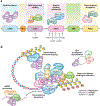Aire in Autoimmunity
- PMID: 38360547
- PMCID: PMC11774315
- DOI: 10.1146/annurev-immunol-090222-101050
Aire in Autoimmunity
Abstract
The role of the autoimmune regulator (Aire) in central immune tolerance and thymic self-representation was first described more than 20 years ago, but fascinating new insights into its biology continue to emerge, particularly in the era of advanced single-cell genomics. We briefly describe the role of human genetics in the discovery of Aire, as well as insights into its function gained from genotype-phenotype correlations and the spectrum of Aire-associated autoimmunity-including insights from patients with Aire mutations with broad and diverse implications for human health. We then highlight emerging trends in Aire biology, focusing on three topic areas. First, we discuss medullary thymic epithelial diversity and the role of Aire in thymic epithelial development. Second, we highlight recent developments regarding the molecular mechanisms of Aire and its binding partners. Finally, we describe the rapidly evolving biology of the identity and function of extrathymic Aire-expressing cells (eTACs), and a novel eTAC subset called Janus cells, as well as their potential roles in immune homeostasis.
Keywords: Aire; Janus cells; autoimmunity; eTACs; immune tolerance; mimetic cells.
Figures



References
-
- Sutphin A, Albright F, McCune DJ. 1943. Five cases (three in siblings) of idiopathic hypoparathyroidism associated with moniliasis. J. Clin. Endocrinol. Metab 3(12):625–34
-
- Perheentupa J 2006. Autoimmune polyendocrinopathy-candidiasis-ectodermal dystrophy. J. Clin. Endocrinol. Metab 91(8):2843–50 - PubMed
-
- Nagamine K, Peterson P, Scott HS, Kudoh J, Minoshima S, et al. 1997. Positional cloning of the APECED gene. Nat. Genet 17(4):393–98 - PubMed
Publication types
MeSH terms
Substances
Grants and funding
LinkOut - more resources
Full Text Sources

